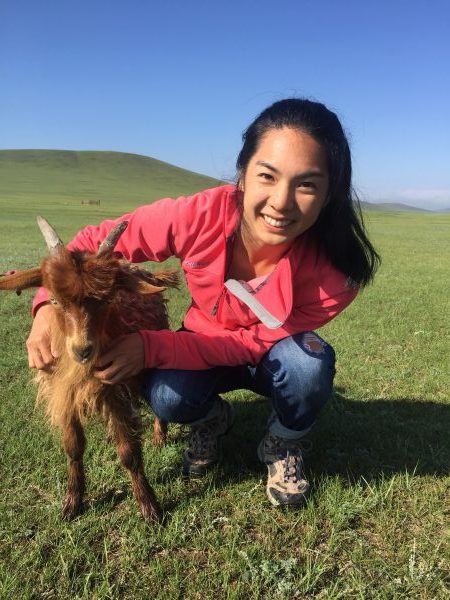 Jennifer Chin (MEM/MBA Class of 2012) recently joined The Nature Conservancy in New York as Director of Conservation Innovation. Five months in, she has embraced an exciting new opportunity to help change the way conservation efforts are conducted.
Jennifer Chin (MEM/MBA Class of 2012) recently joined The Nature Conservancy in New York as Director of Conservation Innovation. Five months in, she has embraced an exciting new opportunity to help change the way conservation efforts are conducted.
We caught up with Jennifer to get her thoughts about her journey.
How did you first get interested in this career path?
Early in my career, I was working at Google, where I had a lot of contact with nonprofits through various divisions in the organization. I felt that nonprofits–conservation nonprofits in particular–could benefit from the approaches to problem-solving that I had learned from working on products at Google. My undergraduate degrees were in English and Journalism, so when I started looking at conservation jobs, I really wasn’t qualified for any of the roles–which led me to the Duke MEM/MBA.
Tell us a little about The Nature Conservancy. What’s your favorite part about working there?
The Nature Conservancy is very large organization. In the New York division, we have about 130-150 staff, depending on the season. It’s an awesome place to work. I think its size has the benefit of not only attracting funding to support the work that we do, but there are also some pretty significant economies of scale and really amazing relationships of trust between The Nature Conservancy and other organizations.
My favorite part of working here is being part of an organization full of really intelligent, kind people. The staff are genuinely seeking to make a difference for future generations, so I think that in and of itself makes it an amazing place to be. It’s also gratifying to know that my work is grounded in the communities and ecosystems of the state of New York. The state is also closely connected to larger geographies, including the Northeast, the Great Lakes, Canada — and of course, New York City, one of the greatest cities in the world. I get to work with a very diverse set of projects and people on a daily basis, and I think the organization is pushing bigger and better conservation outcomes for communities.
Can you share some of the interesting challenges The Nature Conservancy is facing today?
At the end of the day, almost everyone in the conservation world seems to be focused on the climate question. In New York, after Super Storm Sandy, the region has been really focused on natural solutions to reduce damage from flooding. So, that’s one area that’s posed an interesting challenge.
With my technology background, conservation in general is very focused on the on-the-ground work. There is such a big opportunity yet to be captured in terms of understanding how conservation can utilize emerging technologies. Whether that’s using “big data,” whether it’s using emerging hardware like drone technologies, it’s an interesting challenge to figure out how we can create partnerships with organizations that can offer new technology solutions to managing environmental conservation. This field is exploding with potential in that regard, and we can achieve conservation solutions in a number of innovative ways.
What exciting projects do you have planned for the future?
We’ve identified some very specific ideas as R&D initiatives, and we’re going to manage those differently going forward to actually start building what is typically described as the innovation pipeline. I’m pretty excited about that. We’re going to put some resources behind the project, and really structure it in a way that’s more traditionally used in the corporate world. They’re the guinea pigs for how R&D could be fostered and supported inside of a conservation nonprofit.
What ultimate impact do you hope to make?
For me, my role is to integrate the practice of innovation into conservation. Traditionally, conservation work at large NGOs has been funded and implemented only at scale, so the planning also happens on that large scale. My goal is to change the thinking about how projects can be run. I want to create a framework that takes an established field of innovation practice, to teach conservation organizations how to utilize these practices which have been used very effectively in both technology and manufacturing, and to customize that model for conservation.
Do you have any advice to MBAs who may be interested in conservation?
MBAs have so much to offer in the conservation world, and the biggest hurdle has been understanding how to translate what is traditionally designed for a for-profit type of industry into nonprofit. With for-profit organizations, you have customers that can measure revenue, and in nonprofit organizations, that parallel is not so easy to draw. I would advise MBA students to spend some time in the field working on environmental projects with nonprofits, so that they can not only understand the vast constraints that many of these organizations work under, but they can also see where those parallels might be drawn. As a result, when it comes time to actually start making an impact, there’s not so much information lost in translation.
—
RELATED ARTICLES:
- Video: The Nature Conservancy’s Glenn Prickett discusses the value of nature with EDGE
- Marketing nature
- Sustainability at Land O’ Lakes: Q&A with Jessica Wingert (MBA ‘14)
- Read more alumni profiles